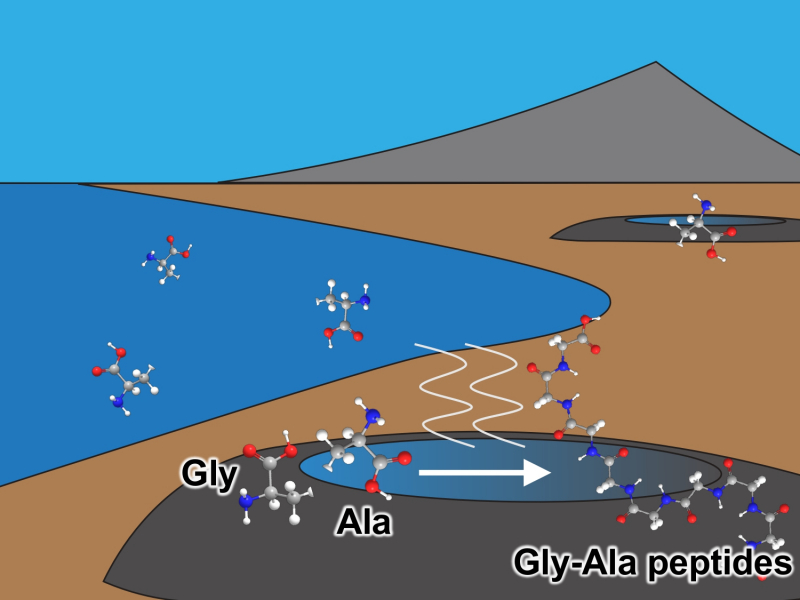
Abiotic formation of glycine-alanine peptides in alkaline evaporative environments
ABSTRACT

Proteins are composed of 20 different amino acids and are essential catalysts of many biological reactions for all extant life. Thus, understanding the origin of proteins is essential to understanding the origin of life. Glycine (Gly) is regarded as a reactive amino acid in peptide synthesis and is also important as the most abundant α-amino acid on the prebiotic Earth. Many investigations on peptide formation have revealed the importance of evaporative environments, reporting the formation of oligopeptides composed of both single amino acids (homo-oligopeptides) and multiple-type amino acids (hetero-oligopeptides). However, the extent of incorporation of amino acids of different reactivities in peptides is unclear. We performed long-period amino acid oligomerization experiments, simulating prebiotic alkaline evaporative environments. Alkaline aqueous solutions containing a 9:5 molar ratio (pH 9.1) or 1:1 molar ratio (pH 9.2) of Gly, alanine (Ala), and sodium hydroxide (NaOH) were dried at 90°C or 130°C in glass vials over durations of 1 to 120 days. The products were analyzed with liquid chromatography-tandem mass spectrometry. The longest peptides detected were 16-mers of hetero-oligopeptides and homo-oligopeptides of Gly. The longest detected homo-oligopeptide of Ala was 4-mer. The composition of the product peptides represents a substantially higher reactivity of Gly over Ala in peptide synthesis, possibly due to the limiting of nucleophilic substitution by the bulkier side chain of Ala over Gly. Higher temperature substantially promoted the rate of the oligomerization reaction but also promoted the consumption reactions of the product oligomers. Thus, when the reaction progressed, exceeding the yield maximum of the lower temperature, the yields of peptides at the lower temperature became higher than the yields at the higher temperature, showing that longer incubation times with lower reaction temperatures are favored in the synthesis of longer and more Ala-rich peptides. Thus, even if we assume the possible higher abundance of Gly over other amino acids on Hadean Earth, these results suggest that evaporative environments over geological timescales, promoted the synthesis of polypeptides that contained glycine and other amino acids such as alanine.
KEYWORDS
Keywords: peptide, glycine, alanine, evaporative environments, prebiotic reaction- Published : 2024
- Released on J-STAGE : 2024/10/31
- Received : 2024/03/06
- Accepted : 2024/08/26
- DOI : https://doi.org/10.2343/geochemj.GJ24018
- J-STAGE URL : https://www.jstage.jst.go.jp/article/geochemj/58/5/58_GJ24018/_article/-char/en
- J-Online ISSN: 1880-5973
- Print ISSN : 0016-7002
- ISSN-L : 0016-7002
All Issues
- Vol.59, 2025
- Vol.58, 2024
- Vol.57, 2023
- Vol.56, 2022
- Vol.55, 2021
- Vol.54, 2020
- Vol.53, 2019
- Vol.52, 2018
- Vol.51, 2017
- Vol.50, 2016
- Vol.49, 2015
- Vol.48, 2014
- Vol.47, 2013
- Vol.46, 2012
- Vol.45, 2011
- Vol.44, 2010
- Vol.43, 2009
- Vol.42, 2008
- Vol.41, 2007
- Vol.40, 2006
- Vol.39, 2005
- Vol.38, 2004
- Vol.37, 2003
- Vol.36, 2002
- Vol.35, 2001
- Vol.34, 2000
- Vol.33, 1999
- Vol.32, 1998
- Vol.31, 1997
- Vol.30, 1996
- Vol.29, 1995
- Vol.28, 1994
- Vol.27, 1993
- Vol.26, 1992
- Vol.25, 1991
- Vol.24, 1990
- Vol.23, 1989
- Vol.22, 1988
- Vol.21, 1987
- Vol.20, 1986
- Vol.19, 1985-1986
- Vol.18, 1984
- Vol.17, 1983
- Vol.16, 1982
- Vol.15, 1981
- Vol.14, 1980
- Vol.13, 1979
- Vol.12, 1978
- Vol.11, 1977
- Vol.10, 1976
- Vol.9, 1975
- Vol.8, 1974
- Vol.7, 1973
- Vol.6, 1972-1973
- Vol.5, 1971
- Vol.4, 1970-1971
- Vol.3, 1969-1970
- Vol.2, 1968
- Vol.1, 1966-1967




